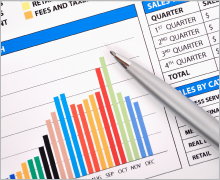Sales Forecasting
Preparing a realistic sales forecast
 Whether your business sells water wings or water filters, auto parts or party dresses, you need to be able to confidently forecast demand in order to thrive. Preparing a sales forecast will help your company take stock of past performance and become fully aware of where you stand today, in order to make the best decisions for future growth.
Whether your business sells water wings or water filters, auto parts or party dresses, you need to be able to confidently forecast demand in order to thrive. Preparing a sales forecast will help your company take stock of past performance and become fully aware of where you stand today, in order to make the best decisions for future growth.
Think of forecasting as the business version of a medical checkup. By regularly taking your operation’s pulse and assessing its general health, you can improve cash flow, control inventory, plan resources and identify trends. Creating a realistic sales forecast can also help prepare you for more successful conversations with your BMO® Representative.
Here are some key steps involved in developing a forecast that will realistically represent future sales.
Determine parameters
Depending on how the forecast will be used, you can prepare a short-term (less than three months), medium-term (three months to two years) or long-term (more than two years) forecast.
If you plan to approach your bank for financing, it could be beneficial to prepare three forecasts for your chosen time frame – conservative, planned and aggressive – to demonstrate that you’ve considered best - to worst-case scenarios.
Do your homework
To determine where your business is headed, you’ll need to know where you’ve been and where you stand now by gathering information both inside and outside of your company.
Internal data. Review company records such as accounting files, financial statements, expense totals and sales reports.
Outside sources. Consider surveying your major customers, distributors or dealers regularly to get an indication of what they plan on buying from you and how you stack up compared to the competition.
There are also market research firms that will survey customer intentions and sell the information to businesses that need the data for sales forecasting.
Don’t forget to analyze your competitors – their pricing, product lines, new offerings, market positioning – to get a sense of how you are doing relative to the market.
Use forecasting models
A forecasting model can be as simple as projecting this month’s sales based on last month’s, or can involve complex mathematical formulas.
Whether you’re using forecasting software to crunch your numbers, or just a simple spreadsheet, it’s wise to first check how well your system works. Test it out by “predicting” the past three months and compare your results to what really happened. Keep testing until you find the method that produces the most accurate results for your purposes.
Understand your business
When making decisions based on future projections, nothing is more valuable than your deep knowledge of the business and its history. Always review the final results to make sure that they seem reasonable based on your experience and understanding of how your individual business works.
Variable factors such as economic or political conditions, weather, industry changes, employee turnover rates or patterns you’ve noticed in your business or others can also have an impact on the final results of your forecast.
Contact your branch to help you find more information about forecasting sales. Also, download the following BMO Bank of Montreal® podcasts for additional information:

